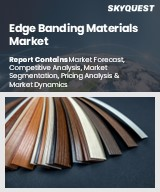
엣지 밴딩 재료 세계 시장 규모는 2023년에 14억 달러, 2024년 15억 3,000만 달러에서 2032년까지는 31억 2,000만 달러로 성장하고, 예측 기간(2025년-2032년) CAGR은 9.3%를 보일 전망입니다.
엣지 밴딩 재료 시장은 소비자 선택의 변화, 정부 이니셔티브, 기술 발전에 힘입어 강력한 성장세를 보이고 있습니다. 기술 혁신은 환경 친화적이고 내구성이 뛰어나며 미학적으로 우수한 엣지 밴딩 제품의 창조로 이어지고 있습니다. 특히 독일의 "Zukunft Bau" 프로그램은 지속 가능한 건축자재를 장려하는 프로그램으로, 가구 생산에 PVC가 없고 재활용이 가능한 ABS 엣지 밴딩의 채택을 촉진하고 있습니다. 이 분야는 또한 머신러닝과 AI를 통해 제조 효율성, 품질 관리 및 사용자 정의가 강화되고, AI 기반 기계가 엣지 밴딩 공정을 놀라운 정확도로 자동화하여 재료 낭비와 인건비를 최소화하는 등 큰 혁신을 목격하고 있습니다. 또한, AI 기반 비전 시스템은 일관된 표면 마감을 보장하고, 예측 유지보수 알고리즘은 기계 성능 데이터를 활용하여 다운타임을 최소화하고 업계의 생산성을 더욱 향상시킵니다.
Global Edge Banding Materials Market size was valued at USD 1.4 billion in 2023 and is poised to grow from USD 1.53 billion in 2024 to USD 3.12 billion by 2032, growing at a CAGR of 9.3% during the forecast period (2025-2032).
The edge banding materials market is experiencing robust growth, propelled by changing consumer preferences, governmental initiatives, and technological advancements. Innovations are leading to the creation of eco-friendly, durable, and aesthetically pleasing edge banding products. Notably, Germany's "Zukunft Bau" program promotes sustainable building materials, fostering the adoption of PVC-free and recyclable ABS edge banding in furniture production. The sector has also witnessed significant technological innovations, with machine learning and AI enhancing manufacturing efficiency, quality control, and customization. AI-powered machinery automates edge banding processes with remarkable precision, minimizing material waste and labor costs. Additionally, AI-driven vision systems ensure consistent surface finishes, while predictive maintenance algorithms leverage machine performance data to minimize downtime, further advancing the industry's productivity.
Top-down and bottom-up approaches were used to estimate and validate the size of the Global Edge Banding Materials market and to estimate the size of various other dependent submarkets. The research methodology used to estimate the market size includes the following details: The key players in the market were identified through secondary research, and their market shares in the respective regions were determined through primary and secondary research. This entire procedure includes the study of the annual and financial reports of the top market players and extensive interviews for key insights from industry leaders such as CEOs, VPs, directors, and marketing executives. All percentage shares split, and breakdowns were determined using secondary sources and verified through Primary sources. All possible parameters that affect the markets covered in this research study have been accounted for, viewed in extensive detail, verified through primary research, and analyzed to get the final quantitative and qualitative data.
Global Edge Banding Materials Market Segments Analysis
Global Edge Banding Materials Market is segmented by Material Type, End-use and region. Based on Material Type, the market is segmented into PVC (Polyvinyl Chloride), ABS (Acrylonitrile Butadiene Styrene), Wood, Melamine, Veneer, Metals and Others. Based on End-use, the market is segmented into Residential, Industrial and Commercial. Based on region, the market is segmented into North America, Europe, Asia Pacific, Latin America and Middle East & Africa.
Driver of the Global Edge Banding Materials Market
The Global Edge Banding Materials market is experiencing a remarkable shift, propelled by rapid advancements in artificial intelligence, data analytics, and digital display technologies. These innovations are enhancing production efficiency, quality control, and customization capabilities. Modern AI-driven machinery can now automate edge banding processes with remarkable precision, significantly reducing material waste and labor costs. Furthermore, AI-powered vision systems are employed to instantly inspect surface finishes, ensuring consistent color, texture, and adhesion across products. This integration of advanced technologies is transforming the sector, enabling manufacturers to meet evolving consumer demands while optimizing operational effectiveness.
Restraints in the Global Edge Banding Materials Market
The global edge banding materials market faces significant constraints primarily due to the high initial costs associated with its implementation. Manufacturers and businesses must invest considerably in specialized equipment, such as edge banding machines, along with acquiring premium materials that meet both durability and aesthetic requirements. In addition to these costs, there may also be expenses related to training employees and enhancing processes to ensure the efficient and effective use of these materials. This financial burden can deter potential market entrants and limit the growth opportunities within the industry, creating a notable challenge for stakeholders.
Market Trends of the Global Edge Banding Materials Market
The Global Edge Banding Materials market is witnessing a significant shift towards sustainability, driven by heightened environmental awareness among consumers and manufacturers alike. As the demand for eco-friendly edge banding materials grows, producers are increasingly investing in recyclable and bio-based polymers, which not only minimize the carbon footprint of furniture but also contribute to achieving international sustainability targets. This trend caters to environmentally conscious consumers and businesses, fostering a competitive edge for companies that prioritize sustainable practices. Overall, the alignment of edge banding materials with sustainability goals is set to shape market dynamics and enhance the industry's green credentials.